As preppers, making sure that there is plenty of food on hand is always on our minds. One way to be sure that you get enough meat is to go hunting. Hunting should be done when in season and with the proper permits. Processing your kill is part of hunting, whether you pay to have it done or you do it yourself. When SHTF, you will definitely need to know how to do the processing yourself.
Most animals that you will butcher have a fat layer, as well as layers of silverskin that protect the muscles. You will want to remove the silverskin the best you can, as it is tough and does not leave a good flavor. The fats depend on the type of animal, but I always try to remove as much as possible.
Needed Items:
As with any home butchering, you will need the same equipment for about every animal:
- A method to hang the animal
- A very sharp skinning knife
- A knife sharpener- whichever type you prefer
- Loppers to make small joint cuts
- Plenty of clean water for washing
- Pans and/or buckets to hold meat cuts
- Assorted knives for cutting meat
- Storage containers or items such as freezer bags
- A hacksaw for the larger bones
Related: Tools The Early Pioneers Used on A Daily Basis
Venison
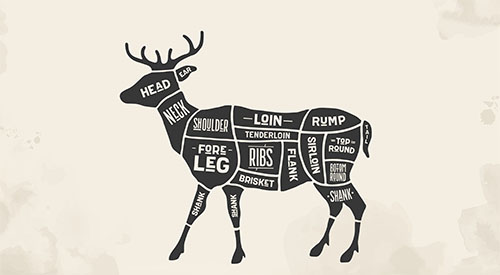 When processing your deer, start by removing the front legs. Remove the leg below the knee by cutting it off; there isn’t any meat in this part. Now grab the shank and pull it slightly away from the body. Start slicing with your knife to remove the foreleg. The meat from the front legs and shoulder can be used as roast or deer steaks. The shank is full of connective tissue and can be used in grind.
When processing your deer, start by removing the front legs. Remove the leg below the knee by cutting it off; there isn’t any meat in this part. Now grab the shank and pull it slightly away from the body. Start slicing with your knife to remove the foreleg. The meat from the front legs and shoulder can be used as roast or deer steaks. The shank is full of connective tissue and can be used in grind.
Then remove the neck meat, brisket and flank; these are good for scrap to grind or cube up for stew meat. Next, cut out the loin and back straps. These are some of the most tender and best cuts of meat on the deer.
Make two long cuts from the rump to the base of the neck, being sure to get all of the meat that you can. There will be two long back straps to cut and an inner loin that you will want to be sure to get.
The hind legs should be removed and the shank used for stew meat. The top round and bottom round will have silverskin between the layers of the meat. These cuts should be separated. Cut them off the bone. These are also excellent cuts of meat for roast. The ribs can provide a rack of ribs or spare ribs, or you can scrape the meat from the ribs and use that for grind also. You can use ground deer meat in place of any burger.
Related: Six Primitive Traps For Catching Game In The Woods
Elk
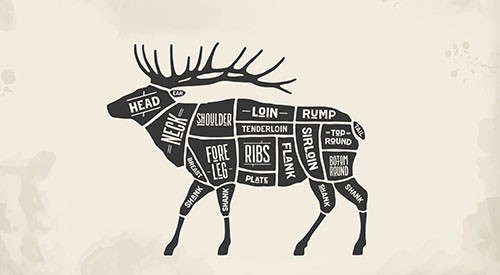 When processing elk, it is about the same as a deer. The difference is mostly size and the amount of meat you get, being the elk is more. The cuts of meat from the elk are the same, with the exception of meat from the breast and plate.
When processing elk, it is about the same as a deer. The difference is mostly size and the amount of meat you get, being the elk is more. The cuts of meat from the elk are the same, with the exception of meat from the breast and plate.
The breast is included in the brisket, which is a meat that is flavorful but needs slow cooking. The plate is below the ribs and behind the brisket. This cut of meat is fatty and has cartilage, so it is a more coarse cut of meat and needs to be cut against the grain. Otherwise, you will process the elk the same as the venison.
Rabbit
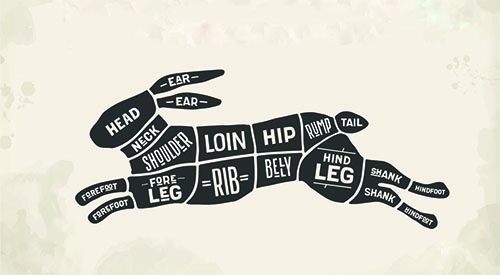 After your rabbit has been culled, skinned and gutted, then you will want to remove the silverskin covering the meat. You can do this all at once, or you can do separate cuts of meat. Removing the silverskin is a delicate process, as you want to be careful not to cut the meat.
After your rabbit has been culled, skinned and gutted, then you will want to remove the silverskin covering the meat. You can do this all at once, or you can do separate cuts of meat. Removing the silverskin is a delicate process, as you want to be careful not to cut the meat.
To remove the forefeet, find the joints and snip them off as they are small and it will cut easily with the shears. Next, cut around the shoulder until you remove the forelegs. There is meat in the forelegs, you will more than likely leave the bone in.
Loosen the hind legs so that you can lay the rabbit open for easier butchering. Remove the flap of meat from the sides of the belly, this can be used for bacon.
Related: How To Smoke Bacon The Old-Fashioned Way
Next, go to the hind legs. The hind legs are the biggest meat section on a rabbit. Start on the underside of the hind leg and slice along the pelvic bone to the ball and socket joint. Firmly grip an end and bend the leg backward to pop the joint out of place. Finish cutting around until the leg is removed.
There is not much meat on the ribs, so you can throw them into the stockpot for use. The ribs are an obvious cut, snip them along the bone just where the loin meat starts. Now the meat rabbit is bred for a long saddle, so there will be plenty of meat in the loin. You will want to cut the loin into serving sizes.
The hip will be worked with the pelvis cut. The rump has some cuts of meat that can be used for stew. The pelvis is good for throwing in the stock pot too.
Bear
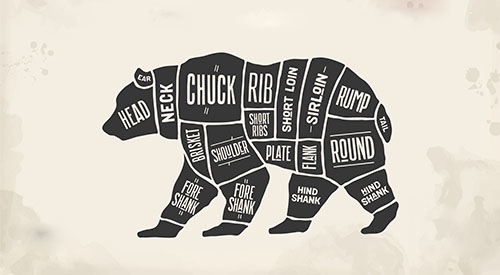 With the sheer size of a bear you will want to butcher it by quartering it up. The bear should be cut in half down the backbone. Then take the half and cut it behind the ribs to have a forequarter and a hindquarter. You will want to remove as much fat as you can before you start processing your bear.
With the sheer size of a bear you will want to butcher it by quartering it up. The bear should be cut in half down the backbone. Then take the half and cut it behind the ribs to have a forequarter and a hindquarter. You will want to remove as much fat as you can before you start processing your bear.
Take the foreleg of the carcass and pull it away from the ribs to locate the joint that connects it to the chest. Cut the joint and remove the leg. Do this on both sides. The neck meat has lots of bones, so it’s difficult to get the meat. Your best option is to use it for grinds.
Related: The Ultimate Meat Processing Charts for Preppers
The brisket is flavorful and cut from the chest. The chuck and shoulder can be used for roasts, or stew meats. Leave the trimmings for ground bear. The upper ribs can be cut into steaks or roasts by removing the bone, and the short ribs can be left as – well- short ribs.
The hindquarter is where you will cut your loins from. To do this, you will first need to remove the belly meat, which is the plate and the flank. These cuts can be used as bacon, if there is enough fat trimmings and if not, you can use it for stews or grinding.
The loin is easy to cut out, as you follow the lines down the backbone and cut it out. It can be left whole, or cut into steaks or roasts. The sirloin is behind that and can be cut into strips for meals or kabobs, or can be left as a roast.
Related: Pioneer Foods We’ll Be Eating A Lot After SHTF
Now the rump is the top of the hip, while the round is more the thigh area. These two cuts of meat are separated by a definite natural seam between them. They can be portioned into desired servings for your family for a roast. Remove the hind leg by pulling it away from the body, and cutting until you come to the joint. Then saw the joint in half.
The shank of all of the legs are flavorful and can be used as soup bones, to flavor soups or stews. You can also remove the bone and grind the bits of meat. I have never butchered a bear, but my brother went on a hunt and brought back some burger. It was very tasty!
Wild Hogs
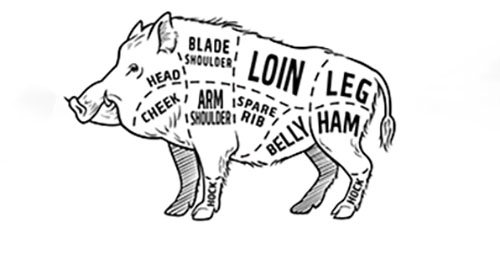 The hog should be halved to make butchering easier. Cut with a saw down the center of the backbone. Be sure to split the breast bone too. From there you can quarter the hog, or butcher it halved.
The hog should be halved to make butchering easier. Cut with a saw down the center of the backbone. Be sure to split the breast bone too. From there you can quarter the hog, or butcher it halved.
The cheeks of the hog are where the jowl meat comes from. The jowl has several uses, from being enjoyed as bacon to flavoring beans. The loin is located along the back and you will want to carefully remove it, follow the loin to the rump of the pig to be sure to get it all.
Starting at the front, the legs produce the blade and arm shoulder. From these cuts come shoulder steaks and roasts.
Under the loin is where you will find the ribs. The ribs can be cut into smaller portions, or left whole as a rack of ribs. Rib chops can be cut here from leaving a piece of rib bone in it.
The belly is where you get your bacon meat from. The leg is the hip of the hog and you can cut pork chops and roasts. The ham is below the leg of the pig and you can cut out some spare ribs from the end of that cut. The whole ham also comes from this cut, and you can choose to leave it bone-in or boneless.
Related: 25 Survival Uses For Leftover Bacon Grease
Be sure to use all of the bits of meat to grind into sausage.
The hock is the knuckle part of the leg. It tastes good smoked and can be used for flavoring soup beans.
Squirrel
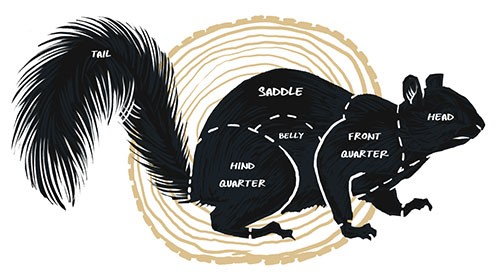
Now, some think that a tree jumping squirrel doesn’t provide enough meat to mess with, but I disagree, especially if you take your bag limit. There are a lot of different meals you can make with squirrel.
After you skin, gut, and wash your squirrel, you will want to cut it up into different sections. The sections that you get from a squirrel are the front quarter, saddle (back strap), belly, and hind quarter.
Start with the meatier parts of the squirrel and remove the legs. Remove the hind leg by bending it backwards and breaking the hip joint. Now cut any remaining tissue and you have two meaty little drumettes.
Next, remove the front legs. This is done by cutting down the outside of the rib cage, around the shoulder and toward the neck. You need to break the collarbone, as this is where the front leg is attached. Then it should come right off.
Related: The Best Way to Train Your Dog For Hunting And Security
The saddle is meaty and can be done in one or two sections, depending on the size of your squirrel. Cut down the back bone and feel where the meat lessens at the ribs. This is where you get the back strap.
The belly has a couple of little meaty flaps, that can be removed. Cut them off the end of the ribs and towards the hip section. The ribs provide some meat. I find it difficult to debone the ribs, so I usually boil them on the bone for stock.
Opossums
I have never butchered or eaten an opossum, but after looking into this and talking to my uncle I am slightly intrigued. To process your opossum, you can hang it or leave it laid.
The rump and loin is where you will find most of your meat. You may want to skip on the liver, in case the animal has consumed something poisonous. If you have a plump opossum, you can probably get some cuts from the front leg and shoulder region.
Cut through the backbone and behind the ribs. Keep the back half for your meat and discard the rest. You can take the meat and slice it in thin strips for jerky or stew. They say that if the meat is thick, it will be tough.
I always try to use all parts of the animal, or as much of it as possible. When I have parts that I can’t use, I make sure to discard them properly. I use some of the bones and scraps of meat as treats for my dogs.
You may also like:
12 Pioneer S kills We Can’t Afford to Lose
kills We Can’t Afford to Lose
The Awesome DIY Device That Turns Air Into Fresh Water! (Video)
How to Dehydrate Chicken for Survival (With Pictures)
How To Repackage Foods in Mylar Bags With Oxygen Absorbers For Long Term

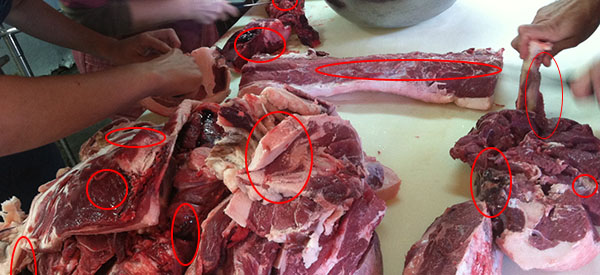




















Would be nice for you to provide the same information for chicken/turkey.
The best article you’ve done in a long time!
Nice article, diagrams and good advice. I’d really love to see a really good, detailed article about how to quickly and efficiently de-bone large animals in the field though. I used to belong to a muzzle-loading club in Colorado and we had a member that worked game-animal processing during the hunting seasons and he was a regular wizard at it. He held a number of classes on how to do it for our members during some of the hunts we’d go on, but I was always working and never got to attend. I really regret that. I’m sure most hunters, especially in possible SHTF situations, would agree it would be a valuable skill to have to be able to quickly collect all the meat (without the weight of the bones) and be able to haul it to a safe location without the added weight to hinder you. Yes, the bones can also be a valuable protein source, but the organs and meat would be your primary goal under certain conditions. Just saying. Thanks for your wonderful and informative article though.
Bones would provide more than just “protein”. Bone marrow is used to make bone broth, a highly nutritious soup base. Bone meal is some of the best fertilizer you can put on your vegetable garden. Try pricing it in the local garden shop or big box garden department.
Although I haven’t a clue about the process, bone char bluing is a deluxe finish put on firearms.
I feel confident others who regularly post have useful suggestions about using bone.
Hello LCC, I will keep this on subject. Since you can’t harvest these animals and butcher them without proper ammo, what is the talk of your neck of the woods with the bullet registration coming up in just a few days? Hope you are sticking up in necessary Bullets to take down these wonderful sources of food and butcher them to fill your freezer since we have helpful charts. See, I kept it in subject and implemented another relatable topic.
Wannabe: Since this is also the year that lead ammunition for hunting anything except humans in the PDRK is verboten, AND since the “suggested” course of conduct for proving to the minions of the regime that your ammunition is, indeed, truly lead free, it is suggested that you carry the original carton with you in an attempt to convince Geraldine Game Warden that yes, those are solid copper, my hunting will be limited to two legged varmints.
I have suggested for some time that what the hunters and fishers of California should do is boycott all hunting and fishing in the state.
Will that affect certain towns, farmers and guides? Most assuredly. Maybe if they scream loudly enough to their “representatives” in Sacto, it will get some ameliorating response.
The Pittman-Robinson Act of 1937 is a double whammy. Not only will the state lose the fees from the sale of licenses, but the 11% excise tax levied on firearms sales and ammunition sales is also based on the number of hunting licenses sold in a state, among other criteria. So the state would lose that money also. In a nutshell, the Department of Fuzzy Cute Animals and Friendly Fishes would face a devastating lost of funding. It used to be called the Department of Fish and Game but that wasn’t p.c. enough so the name got changed a couple of years ago to something warmer and fuzzier to make all the bambiests feel warm and cozy.
Nothing catches the attention of pols everywhere like money, including the dramatic reduction of same.
The impact of recent legislation in the past several years has seen the reduction of hunting licenses from almost a million a year down to just slightly over 200,00 in the last year reported.
We have also be struggling with stupid regulations regarding dating on fishing and hunting licenses. They are issued yearly and all expire on the same date the following year. Fishing licenses are January 1 to December 31 and hunting licenses are July 1 to June 30. Doesn’t matter if you bought a license in March for the spring turnkey hunt, it is a dead piece of paper on June 30. If you took your grandson fishing over the Christmas holidays and bought licenses for him and for you, they are toilet paper on at midnight December 31.
We have been trying to get that changed for years and years. Bill after bill has been introduced to die in committee mostly, sometimes making it as far as the floor of the originating house.
So short answer to your question, my hunting in the PDRK is going to be limited to two legged varmints, no season, no bag limit and still able to use lead bullets.
left coast chuck,
I like your idea and description of your regulators. Here in Ohio our Department of natural Resources, Division of Wildlife are actually a pretty good group of people; but, like everywhere else, license sales and P-R moneys are important to those state employees keeping their jobs, so you might also have an ally in Geraldine and her friends when they are facing the unemployment line.
Ohio: As with any large group, some game wardens are great people and then there are others who are gigantic rectal orifices. Unfortunately, the rectal orifices seem to greatly outnumber the great people, but then that seems to hold true for too many groups of people.
It is worst than I thought. No lead for hunting? That was tried here in Texas and it failed miserably. My goodness fill out gun control is just around the corner of legislative gun grabbers get the right people in. Sounds like California is already set up for it. Just hope the good people like you who live there will stand up against all of this.
Wannabe,
You need to think out of the box a bit. Every one of these animals may also be harvested with archery equipment, which here in Ohio would be Bow and Cross Bow.
True, arrows are not controlled by our masters in Sacramento yet. Unfortunately in the PDRK, crossbows are considered firearms for hunting purposes and so are only allowed during regular firearm hunting season.
As far as I know, there is no limit on purchase of lead balls for muzzle loaders, but the lead restriction for hunting other than two legged predators is in full force and effect even for muzzle loaders. Can’t have all the nasty lead just laying around causing all kinds of problems, now can we?
Remember the big hoo-haw a few years ago where a dentist, not a metallurgist raised a false rumor about lead causing health problems for hunters? My first thought was, how long ago did the first owner of a firearm say to himself, “Hmm, This kills people pretty handily. I wonder if it would work an a deer?” and proceeded to prove that it did work quite nicely on all kinds of animals. Was that eight hundred years ago or longer? People have been eating game killed with lead balls for centuries. In fact, many people have walked around with one or more lead balls in them and lived long and fruitful lives.
As I recall the jerk who raised the phony problem proclaimed that he was a “hunter” himself but just wanted to alert fellow hunters to the problem. Yeah, my son has a “friend” who proclaims himself to speak for hunters. The last time he hunted by his own admission, lead shot for water fowl was still allowed for hunting. How long ago was that?
What is really bothering me about all this, of course not as much that it’s even happening at all, is no one is talking about it. No conservative talk shows, no websites, I did not hear about it until you mentioned it in a comment for a different article.
left coast chuck,
I would say that you and other should just leave; but, I know that is not a realistic option for everyone. I’ve been to the PDRK for both business & pleasure; but, as crazy as it might sound, I prefer seasons, including the ice and snow in winter.
Here crossbows are treated like other archery equipment, with the only restriction being the minimum draw weight. Archery season for whitetail deer allows the best) longest) chance to bag a deer and this year runs from Sept. 28, through Feb. 2, 2020 with youth deer gun: Nov. 23-24, 2019 & Deer gun: Dec. 2-8, 2019; Dec. 21-22, 2019.
Our only restriction due to mostly flat terrain is we cannot hunt deer with centerfire rifles such as .308; but, may use muzzleloaders 36 caliber & larger. Handguns with 35 caliber straight wall cartridges and rifles using those same handgun cartridges are also legal. Note that archery season overlaps gun season, so archers may hunt the entire time.
Do you have a method of water bath canning? I don’t have a pressure cooker.
Dusty, are you referring to using a water bath method to canning meat? If so I would not use it for meat. I don’t think temperatures and pressures get high enough to kill all the bacteria. It is only used for vegetables. No I would not use it for meats. Pressure canning meats is wonderful and they last a long time if done right and stored right. I’m eating salmon done two years ago and of course it can last longer than that.
Wannabe,
The pressure is not what kills the bacteria, specifically, the Clostridium Botulinum; but, the heat. Water bath canners cannot achieve temperatures above 212°F @ sea level, and even lower than that at altitude; but, the Clostridium Botulinum requires at least 240°F for 10 minutes to kill it, and pressure canning is the only way to create that temperature.
Water bath canning is also not suitable for vegetables, since unlike fruits, they contain a pH that is too high.
Clostridium Botulinum can either be killed with heat and time or have its growth inhibited by a low pH, acidic environment of 4.6 or below, meaning that meat and vegetables must be pressure canned, unless you are pickling them, with an acidic mixture, usually containing vinegar & sugar.
When yeast eats sugar it excretes waste in the form of CO2 and alcohol; but, when, Clostridium Botulinum eats, it excretes a potent neurotoxin that causes botulism poisoning.
For that reason, foods must be either pressure canned to kill the bacteria or contain enough acid to inhibit it from growing and excreting the toxin.
Dusty,
Meats of any sort or low acid vegetables should NEVER be water bath canned, lest you provide the perfect environment for the Clostridium Botulinum bacterium that cannot be killed with temperatures below 240°F. Water bath canners cannot exceed 212°F and may be less at altitudes above sea level, allowing the deadly botulism neurotoxin to contaminate your food.
A pressure canner is an indispensible tool that will last a lifetime. While the top of the line ”All American” is rather expensive, Presto and Mirro make food ones starting around the $30-50 range. My Mirro was purchased in 1974 and except for replacing the gasket, still works quite well.
Personally I don’t think it’s worth the chance to water bath can meats and vegetables, since what you save is small in comparison to what it could cost you.
Here’s a recent (2017) case where water bath canned potatoes made people and a dead. https://www.cnn.com/2015/04/28/health/potatoes-to-blame-for-botulism/index.html
IF you are talking about water bath canning any sort of meat, DON”T!! It can kill you! Although I do know that the Amish just use water bath and let the bottles boil for 4-5 hrs. straight!
isnt bonemeal just crushed bone?? i dont know personally and i figure you might since you’re older than me.
young prepper,
yes, bone meal is just crushed or more typically coarsely ground animal bones.
Gently crushing and boiling them releases nutrients in the bone; but, more significantly from the marrow. This ”Bone Broth” makes a great nutritious soup base and uses a part of the animal that might otherwise go to waste.
After seeing a possum climbing out of the rotting stomach of a dead horse one time, my grandfather (born in 1888, Kentucky) said: “no self-respecting white person would eat a possum”. That’s saying a lot since with 11 children they pretty much ate everything else.
My experience with skinning out a possum is limited to one I shot when I was in high school a couple of years ago. heh heh heh.
I don’t know if that particular possum was typical of the species or not, but it had so much fat on it and the meat was so greasy, it was difficult to skin and cleaning up afterwards was a chore because the fat and grease was really hard to get off.
I don’t know about other areas, but out here in the PDRK with all the bambiests and other nature lovers, possum are as common as ticks on a hawg. They love dog food and cat food which stupidos leave out for Fido and Cuddles. They also love foraging in the dumpsters of grocery stores and Mickey D type restaurants. I believe that they are more omnivorous than even hawgs and will not turn up their nose at anything that can be chewed up.
Based on my sole experience with that possum which hardly makes me an expert, I would have to be really, really, really, really hungry before I would contemplate chowing down on a possum. Possum or seagull. I don’t know which is worse. Both are mobile garbage disposal units.
left coast chuck,
I fully agree with your experience with possums.
Nasty, smelly, greasy, garbage compactors that will eat anything.
I loved the articles and diagrams!!! Excellent job!!!!
Instead of A hacksaw for the larger bones a bone saw should just be part of your kit.
This is pretty much the same for most animals; but, you need to put the process in the correct order. First you split open the gut and chest, to gut the animal, clean out the entrails, and get it to cool off by washing it with cold water or even ice. Skinning comes later, since the important thing is getting all of the meat cooled down, since it essentially starts to spoil (rot) the moment it dies.
As for Opossums, I’ve tasted it from someone else that had the meat and found it to be a greasy, nasty meat, only useful if I were actually starving to death.
One of the best things you can do with the bones is crack them open to expose the marrow, and then simmer them in water, later straining out any chunks. Bone broth is a great way to start a tasty nutritious soup stock as a base.
Great article and easy to follow for us folk who have never hunted. Two questions though.
I’ve read that some wild game has sent glands that have to be removed before they taint the meat. What does the neophyte look for?
Also, could you address processing fish next? Thanks!
Scent, not sent. Autocorrect is my worst enema.;)
Ground hogs are good eating, they eat the same a rabbits so its clean meat. Now with possums we always kept them in a cage and fed them table scraps for a couple of weeks to clean them out before killing and cooking.
That’s a good suggestion. You need to do the same with snails, I have read that one feeds them cornmeal to clean them out before consuming them. That is something I really need to research, snail raising for food purposes. I’ve never prepared them but have had them in restaurants. The first time on a dare. Actually, they are kind of rubbery but the garlic butter is great. Hold the snails. Just bring the bread and the melted garlic butter.
left coast chuck,
I have done this with both garden snails and crawfish (AKA crawdads or miniature freshwater lobsters); but, someone showed me a slightly better way. Use a mixture of damp cornmeal and finely grated carrots and when the snail or the crawfish starts pooping orange, you know they are thoroughly cleaned out.
We’ve not raised them but often see them in groups in the garden.
If they are rubbery they are overcooked. Slice into strips and sautéed in butter they are pretty good.
Ohio: Thanks for those tips. We have an abundance of garden snails here in SoCal and while one would need a real abundance of them to have a life sustaining quantity, they would certainly add protein to the diet and probably not be in as much demand as other forms of fauna. Certainly easier to catch. I don’t move real fast these days, but even I can run down a snail.
I have read somewhere that orange grove owners make somewhat of an attempt to harvest them and sell them commercially but I don’t know how big the market is. Most folks usually say, “Snails? Eeewwww!”
This is totally off topic, but I thought it was so clever and useful, that I must pass it on.
As many know, I follow the news on NHK (Japanese National Broadcasting Company) the Japanese equivalent of BBC. Since the Fukushima tragedy, they have been running PSAs about various aspects of simple prepping ranging from how to make slippers for use when one is living in a gym; various ways to make useful things from plastic bags ranging from raincoats to waders to making containers waterproof to carry water.
The most recent PSA involved making a personal flotation device using 1-liter or 2-liter plastic bottles. One needs a fairly large, thin fabric shirt such as on overly large T-shirt.
While wearing the shirt, insert the bottle without the bottle cap on up into the shirt high on the chest. Screw the cap on the bottle with the undershirt in between the bottle and the cap. Insert other bottles on the same level across the chest and back. After all the bottles are inserted and the caps screwed on, tie a string or fasten a belt around your waist just below the bottoms of the bottles. Voila! A PFD (personal flotation device). Four 1-liter bottles will float a child. Six 1-liter bottles will float the average sized Japanese person. A chunky American might need six 2-liter bottles to float.
The Japanese government is sponsoring a campaign to gather such tidbits of information from the public and from public safety officers, ie. firemen, police, and other first responders. They screen them for simplicity and usefulness and then run PSAs on NHK to inform the Japanese public of the information.
There is a lot wrong in Japan, but in the emergency response field they have really taken hold since Fukushima where their emergency response people performed much like FEMA in New Orleans — well, not that badly. That was a world class goat rope which will be a goal difficult to reach.
For the few readers who do not know what the abbreviation PSA stands for, it is Public Service Announcement. That is where some public agency offers advice such as the PSAs now running in the PDRK which link nicotine to brain disorder in teenagers. No, it is not Adderol or the other chemical substances that we are jamming down the throats of our children to keep them docile and making them crazy, it is demon nicotine. Whoa thunk? Here all along I thought it was nascent hormones that made teenagers weird.
See what I mean about the Japanese government having its head screwed on slightly straighter than the U.S. government — at least the government in the PDRK. I am not sure the feds are involved in the nicotine silliness. Shades of Reefer Madness. Anyone remember when the government was telling us that marijuana made users crazy?
Well, I got really off topic there toward the end. Sorry about that. Sometimes I just lose control and let it spill out.
left coast chuck,
I did not know and would like to know if you listen or watch NHK broadcasts & how. I of course have internet and numerous other off (or on) the air communications equipment and I’m always looking for additional independent sources of news. My satellite used to carry BBC America; but, have dropped that source.
Some interesting ”field expedient “ techniques I will not comment on; but, well worth the time to watch or listen myself.
Thanks much for the mention.
Vaping is worse by far…. I’ve been saying that since they came out with them and everyone argued with me. (Who’s right now, huh?)
Typical of our own government and their effed up priorities, isn’t it?
Miss Kitty,
Worse by far than what?
I know personally of a few adults who successfully used vapping to quit smoking cigarettes.
I do not however understand why anyone would voluntearily inhale anything but air on purpose.
Who argued with you and what was the context?
Vapping as well as many other modern devices and techniques have their place under the right circumstances.
How many people are killed by vapping vs. by alcohol or distracted driving while using Smartphone’s., to which some people are seemingly addicted?
Somehow I was under the impression that prepping, AKA self reliance was trying to do things without government help or intervention, so I don’t get your point.
Should the government become mommy & daddy and ban the vapping devices?
When they try that with firearms, we all rightfully get upset.
What happened to personal responsibility?
Wild rabbit: how do I cook wild rabbit as I hear they have worms. If they are cooked in a pressure cooker would that take care of parasites and anything else. What time of year is best for butchering wild rabbits. I raised domestic rabbit for a number of years and know how to butcher, but not sure ab out wild bunnies. I live in a place here in NV were we have lots of rabbits. Are they good for dog food. I just want to be safe.
Star,
You would butcher them just like domestic rabbits and harvest them any time, in season of course. Whether using a pressure cooker, a spit over coals, in the oven, or in a skillet, you need to thoroughly cook them until the internal temperature reaches 160° in which case any living organism should be dead and harmless.
I would comment that if harvesting wild rabbits in the summertime out here ( SoCal) that one use rubber gloves while handling the rabbits until cooked. Because of the heat and the frequent presence of tularemia in rabbits in California, Arizona, Nevada and maybe other states, the prudent hunter wears gloves while processing raw wild rabbit meat.
For some reason tularemia seems to taper off in the colder months but not 100%, so again the prudent hunter wears rubber gloves while handling wild Bugs Bunny carcasses.